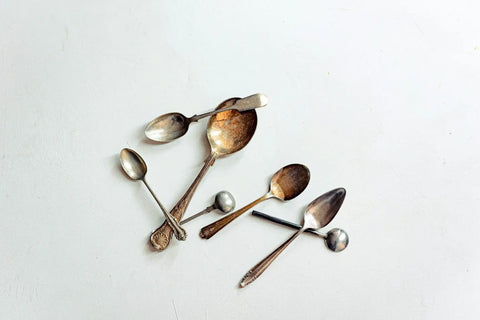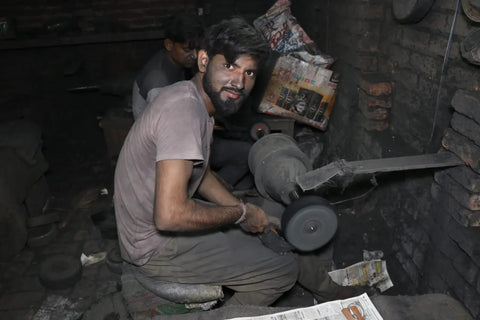Have you ever wanted to throw a cocktail party with an eye-pleasing cheese board? Maybe you have a cheese knife set at home that someone gifted you but you aren’t sure how to use them.
We think that every gathering needs a cheese plate so we put together a list of the most common cheese knives with tips on how to use them.
You’ll also learn some cheese-serving etiquette, starting with this important tip: Every type of cheese on your cheese board must have its knife – no sharing.
Putting together a cheese platter is simple. Creating a theme can be fun, like serving cheeses from a certain region or cheeses made from sheep’s milk only. And if you’re wondering how many cheeses to serve, most experts agree that serving three types of cheeses is just right.
Follow these tips for what cheese knife or tool to use and you’ll have all your guests saying: “Cheese!”

Pronged Cheese Knife
Chances are you’ve seen this part-knife-part-fork-looking tool next to a lovely wedge of Brie on a cheese board. The narrow blade means there is less surface area for soft cheese to stick to. This multipurpose tool is for cutting a piece of cheese and then picking it up with the prongs to serve or transfer to your plate. A pronged cheese knife is a must-have tool for your cheese platter.
Best for semi-soft to soft cheeses like Parmesan and Brie
Cheese Board Etiquette: Never cut the tip or nose of a cheese wedge –that’s the best piece. Instead, cut the wedge into slices along the long edge of the cheese. Digging out the gooey part of a wheel of Brie is just bad form.

Cheese Plane or Shaver
This handy cheese plane makes it easy to slice thin, even cheese slices. Thin slices get up to serving temperature quickly, so the cheese tastes delicious and has a pleasant texture. For cheeses with a rind, simply trim the rind away from one side and then shave across for triangle-shaped slices. If you want you can slice some young Gouda, roll it, and place it on a tray next to some sliced baguettes.
Best for semi-soft to semi-hard cheeses: Muenster, Gouda and Manchego
Cheese Board Etiquette: The rinds of soft cåheeses are edible but hard rinds can be quite dry and brittle.

Stilton scoop
Add a traditional touch to your cheese board with the Stilton scoop. Traditionally, this is how to serve a large block of Stilton cheese. Instead of a knife, use this spoon to scoop out this crumbly cheese from the center.
Best for blue cheeses: Stilton and Roquefort

Cheese Fork
The cheese fork is helpful on any cheese platter. It has two pointed prongs for picking up cut pieces of cheese for plating. Or use it to break up blocks of aged cheese into smaller, more manageable chunks. On your charcuterie boards, this fork helps pick up meat slices and pickles.
Best for semi-soft to hard cheeses: Feta, Gouda, Cheddar and Parmesan
Cheese Board Etiquette: Use the utensils on the cheese platter to plate your cheese. Once it’s on your plate feel free to use your fingers.

Cheddar Cheese Knife
Some call this knife a mini cleaver or cheddar cleaver. Whatever you call it, it is just the thing for cutting hard cheeses. It has a wide blade with a long sharp edge and a long handle which makes it easier to apply force and balance when pushing down to cut slices through hard cheeses. Notice the handle runs along the top of the knife so your knuckles don’t hit the cheese board when slicing.
Best for semi-hard to hard cheeses: Cheddar, Colby, Fontina

Flat Cheese Knife
Also called the chisel knife, this flat cheese knife is perfect for cutting slices or creating cubes. The sharp edge is at the bottom of the blade. Hold it vertically and push through the block of cheese in one motion. Another way to use the knife is like a chisel for shaving down hard cheeses.
Best for semi-soft to semi-hard cheeses: Swiss, Gruyere, Provolone

Cheese Spreader
The cheese spreader, butter knife, or spatula cheese knife is another must-have for the cheese aficionado. It has a thin, flexible blade and dull edges. Use it to spread soft cheeses on baguette slices or crackers. It also makes a great addition to your Sunday brunch table, for spreading butter, jams, and preserves.
Best for soft cheeses: Mascarpone, Stacchino, Brillat-Savarin and Cream cheeses
Gathering friends and family together for good cheese is one of life’s simple pleasures. When it comes to serving cheese, having the right knife and tools is essential for serving balanced portions of cheese and creating eye-pleasing cheese presentations.
Are you a cheese lover? Our cheese knife sets have everything you need to make the most of your cheese-eating experience.



